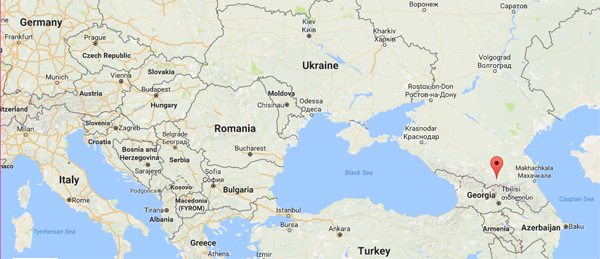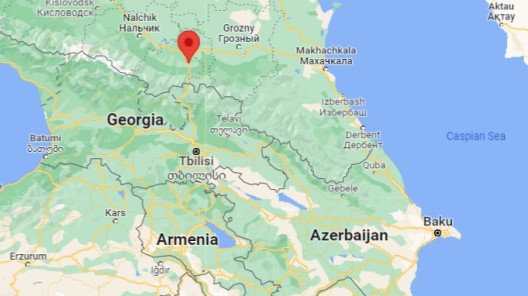
Michaelsdorf: Information | Family List/Census | Surnames | Ship Manifests
Michaelsdorf Information
Page Navigation: Michaelsdorf Location, History, References
Michaelsdorf was a historical German settlement in the North Caucasus region of Russia, established in 1861. Other names for this colony include Vladikavkaz, Mikhaylovskoe, and Mikhaylovskaya, Михайловская, Михайловское. This was a Germans From Russia community.
Location
Michaelsdorf, indicated by the red pin on the map below, is east of the Black Sea and to the west of the Caspian Sea. Historically part of South Russia, in the North Caucasus region, Michaelsdorf is located in the present-day country of North Ossetia-Alania. It is situated on the northern outskirts of the capital city, Vladikavkaz, and is located on the Terek River and at the northern foot of the Caucasus mountains.

Vladikavkaz
The present-day population of Vladikavkaz is primarily Russian, Ossetian, Armenian, and Georgian. Founded in 1784 as a fortress during the Russian conquest of the Caucasian region, it was long the military and political center of Russia in the Caucasus.2 In 1932 the city was renamed Ordzhonikidze in 1932, Dzaudzhikau (Dsaudshikau) in 1944, again Ordzhonikidze (Ordshonikidse) in 1954, and once again Vladikavkaz in 1990.3 Also spelled Wladikawkaz.4
History of Michaelsdorf
The first German colony in North Ossetia was founded in 1861 on the northern outskirts of the city of Vladikavkaz on the right bank of the River Terek, it was called the Vladikavkaz German Colony.5 On 13 Nov 1876, this colony was renamed Mikhaylovskaya Colony (Michaelsdorf).6 The original settlers consisted of 40 families: 37 of which came from the Saratov Oblast; 1 family from the Samara Oblast; and 1 family from Novgorod Oblast, and 1 family, that of August Brenz, was identified as a foreigner.7
The following information was written by Sergej Kindsvater and posted on an internet message board (rootsweb) in 2003, no longer available, and copied here for preservation:
“This is a summary of an article by L.K. Gostieva called Germans of North Ossetia: History and Presence, presented at a russian-german conference in Anapa in September 1994.
Migration to the Terek Oblast from the inner parts of Russia was not as intensive and of a much lesser scale as one to Stavropol and Kuban regions – due to a very scarce land resources available there. Especially Vladikavkaz was known for very few available lands, but nevertheless most migrants from inner Russian regions liked to settle close to this central city.
In 1874 there were 2974 germans in the Terek Oblast, 297 of them settled down in the Vladikavkaz Okrug. {Central State Archive of Republic Alania- North Ossetia, Fond 11, Opis 49, Delo 8, List 34}.
First german colony in North Ossetia was founded in 1861 on the north outskirt of Vladikavkaz on the right bank of the River Terek. It was called Vladikavkaz German Colony. {Central State Archive of Republic Alania- North Ossetia, Fond 11, Opis 52, Delo 118, List 4}.
According to the cense lists 40 families settled down there (148 men and 143 women), 37 familes came from Saratov Govt, 1 Family – from Samara Govt, 1 from Novgorod Govt and 1 family of a foreigner August Brenz. {Central State Archive of Republic Alania- North Ossetia, Fond 11, Opis 49, Delo 8, List 45. 81-87}.
The colony’s original location in the Petro-Pavlovskaya Soldatskaya Sloboda (town part of Vladikavkaz) proved to be very unfavorable and in 1887 to satisfy colonists’ request it was moved to a new place in 9 verst beneath Vladikavkaz, close to the former Potemkin bridge. {Central State Archive of Republic Alania- North Ossetia, Fond 11, Opis 52, Delo 118, List 4}.
On 13 November 1876 on request of the inhabitants Vladikavkaz German Colony was renamed to Mikhaylovskaya Colony (Michaelsdorf). {Central State Archive of Republic Alania- North Ossetia, Fond 11, Opis 52, Delo 118, List 6}.
At the end of 1889 Michaelsdorf counted 513 inhabitants (83 families), they had 1250 Desyatin agricultural land, had 316 cows, 287 horses, 194 sheep etc. Colony had 3 blacksmith shops, 2 mills and 1 factory.
Administrative belonging to Michaelsdorf are listed Datscha of Zuevitch with 46 inhabitants (germans), Khutor of Prokhasko – 20 courts with 145 inhabitants. There were germans also on the Dachas of Atabekov (6 germans) Sorokoumovski (5 germans), Surveyor Yakovlev (14 germans). There were german watchmen at the Dachas of the Teacher Orlov (3 germans) and salesman Leitholz (5 germans).
According to the data as of 1 July 1914 Mikhaylovskaya Colony had 1250 Desyatin land, 115 houses with 1155 inhabitants.
Another german colony Novy Lars (Dzakhontov-Lars) was founded in 1887 close to the station Beslan. There were 54 inhabitants who came from Bessarabia, Taurien and Stavropol Govts. In 1918 all inhabitants of Novy Lars moved to Michaelsdorf.
In 1888 germans from Kuban region founded colony Emmaus close to the town Zamankul. In 1896 there were 29 houses with 160 inhabitants. {Central State Archive of Republic Alania- North Ossetia, Fond 11, Opis 5, Delo 384, List 4-6}.
In 1908 germans left Emmaus and moved to Michaelsdorf there houses were taken by ossetins.
1882 on the northern part of plain Ossetia a new colony Gnadenburg was founded where 40 families from Germany settled down. {Central State Archive of Republic Alania- North Ossetia, Fond 11, Opis 52, Delo 220, List 1-2}.
In 1888 they were offered tax benefits and non-conscription till 1892 under condition they will receive russian citizenship. Some of the original Gnadenburg colonist families disappered though (died, went back to Germany, some went to other places in Russia) and as of 1888 there were only 28 courts with 120 inhabitants. {Central State Archive of Republic Alania- North Ossetia, Fond 11, Opis 52, Delo 220, List 43-45}.
14 more families came to replace them, but didn’t receive any benefits as they weren’t russain citizens yet (according to the 1864 naturalization law citizenship was to be taken by foreigners after 5 years of residence in the country, in case of refuse to become a citizen of Russia a foreigner had to expelled immediately with his property confiscated).
In 1889 in Gnadenburg there were 52 courts with 290 inhabitants. In 1900 there were 78 courts with 495 inhabitants. {Central State Archive of Republic Alania- North Ossetia, Fond 20, Opis 1, Delo 2445, List 80} In 1914 there were 95 courts with 567 inhabitants.
There were some germans in Vladikavkaz itself. In 1874 there were 248 germans. In 1882 In Vladikavkaz an evangelic lutheran church college was opened.
In soviet period according to the cense of 1926 there were 1502 germans in North Ossetia. According to the cense of 1989 there were 3099 germans in North Ossetia, 399 of them – in Mikhaylovskoe (Michaelsdorf). ” 9
Footnotes
1. Google Maps, Mikhailovskoe, North Ossetia-Alania (https://goo.gl/maps/y1wWkLXkWJLkFmHu7 : accessed 23 Mar 2023).
2. Vladikavkaz, wikipedia.org (https://en.wikipedia.org/wiki/Vladikavkaz : accessed May 2003).
3. Vladikavkaz, www.encyclopedia.com (https://www.encyclopedia.com/reference/encyclopedias-almanacs-transcripts-and-maps/vladikavkaz : accessed May 2003).
4. Georgia, The Imperiia Project, (https://imperiia.omeka.fas.harvard.edu/document/730 : accessed 23 Mar 2023).
5. Sergej Kindsvater, Summary of an article by L.K. Gostieva.
Rootsweb.com (https://lists.rootsweb.com/hyperkitty/th/read/GER-VOLGA/2003-04/1050721591 : accessed Apr 2003); citing L.K. Gostieva, ‘Germans of North Ossetia: History and Presence’ presented at the Russian-German conference, Anapa, Sept 1994. Their citation, Central State Archive of Republic Alania- North Ossetia, Fond 11, Opis 52, Delo 118, List 6.
6. IBID. Sergej Kindsvater, Summary of an article by L.K. Gostieva.
Rootsweb.com . Their citation, Central State Archive of Republic Alania- North Ossetia, Fond 11, Opis 52, Delo 118, List 6.
7. Sandy Schilling Payne, Germans from Russia Settlement Locations,
(https://www.germansfromrussiasettlementlocations.org/2016/11/new-map-caucasus-colonies.html : accessed 23 Mar 2023).
8. Sergej Kindsvater, Summary of L.K. Gostieva article.
Rootsweb.com; citing L.K. Gostieva, Germans of North Ossetia: History and Presence,
Russian-German conference, Anapa, Sept 1994. Their citation, Central State Archive of Republic Alania- North Ossetia, Fond 11, Opis 49, Delo 8, List 45. 81-87.
9. Sergej Kindsvater, Summary of L.K. Gostieva article.
Rootsweb.com; citing L.K. Gostieva, Germans of North Ossetia: History and Presence,
Russian-German conference, Anapa, Sept 1994.
Other References
American Historical Society of Germans From Russia (https://ahsgr.org).
Patrice Miller, [GV] Details on Michaelsdorf Caucasus, Germans from Russia GER-VOLGA Message Board Post (https://lists.rootsweb.com/hyperkitty/th/read/GER-VOLGA/2003-04/1050721591 : accessed 18 Apr 2003).
Karl Stumpp, The Emigration From Germany to Russia in the Years 1763 to 1862
; American Historical Society of Germans from Russia, Lincoln, Neb., 1973.
Karl Stumpp, Karte der deutschen Siedlungen im Nord und Südkaukasus
(Map of the German settlements in the North and South Caucasus). AHSGR, Landsmannschaft der Deutschen aus Russland (1960). #J4.
Tatiana Plokhotnyuk, The Formation of German Colonies in the North Caucasus,
Journal of AHSGR (Winter, 2002).
Tatiana Plokhotnyuk, Stavropol State University, Rossiiskie nemtsy na Severnom Kavkaze/Russian Germans in the North Caucasus,
Moscow, 2001.
Timothy Kloberdanz, Caucasus Germans,
Plains Folk, North Dakota’s Ethnic History, NDSU, 1988, pp. 163-164.
The Center for Volga German Studies
https://en.wikipedia.org/wiki/Caucasus_Germans

